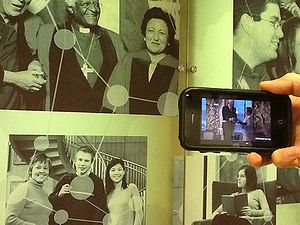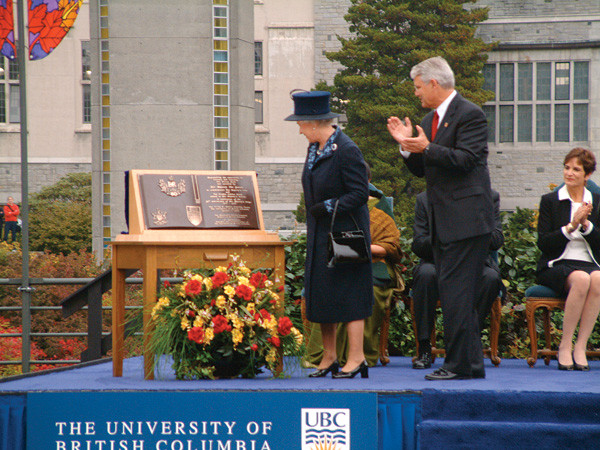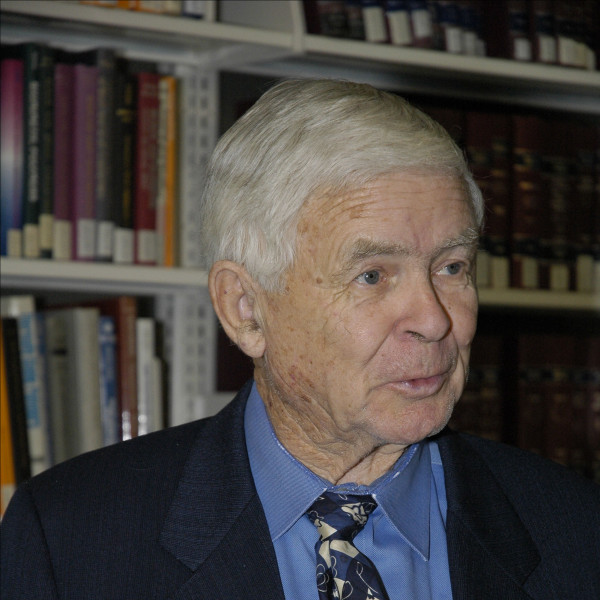IKBLC Virtual Museum
This is the sandbox for the IKBLC Virtual museum
Recognition Wall
Fifteen Points of Interest
1. Dalai Lama, Tutuu, Ebadi
Script:
In 2004, UBC hosted the Dalai Lama, Archbishop Desmond Tutu. The conferral of honorary Doctor of Laws degrees on His Holiness the Dalai Lama, Professor Shirin Ebadi and Archbishop Desmond Tutu marked a historic first for both UBC and SFU. The two separate convocation ceremonies for the three Nobel Laureates were a dramatic statement that the world needs visionaries of this caliber if it is to steer a course for humanity. They were equally a statement that universities have a role to play in that challenge.
UBC’s convocation took place at the Chan Center for the Performing Arts on Monday April 19, 2004. Following remarks by the Honourable Iona Campagnolo, Lieutenant Governor of British Columbia and UBC President Dr. Martha Piper, the three degrees were conferred by Chancellor Allan McEachern.
2. Queen
(Link: http://www.library.ubc.ca/archives/royalvisit/)
Script:
UBC has had the honour of welcoming royalty on several occasions, with Her Majesty Queen Elizabeth II and HRH Prince Philip, Duke of Edinburgh visiting the university in 1951, 1959, 1983 and 2002. Shortly before her ascension to the throne in 1952, Princess Elizabeth and the Duke of Edinburgh toured Canada in the fall of 1951. As part of this tour the royal couple attended a football game on the University campus on October 23rd, 1951. Her Majesty Queen Elizabeth II and His Royal Highness The Prince Philip dined with representatives of the entire University family in the splendour of U.B.C.’s new faculty club on July 15, 1959. While in British Columbia in 1983, Queen Elizabeth and Prince Philip paid a brief visit to the UBC campus where they toured the Museum of Anthropology, Asian Centre and the Health Sciences Centre.
3. Students #1,2, and 3
video found – Tape #3 (0:20-1:10) & (3:48-3:56)
Script:
With high ceilings, movable furniture, and a location in the heart of campus, the Irving K. Barber Learning Centre is a favorite study spot for students. Listen in on what students think about the Learning Centre.
4. Student #4
video found – Tape #5 (1:25-2:50) & (4:27-6:53)
Script:
The Irving K Barber Learning Centre offers a variety of inspiring teaching and learning spaces, technology and access to library collections and services. The Learning Centre is home to several academic programs and units, Ike’s Cafe, the Chung Collection and the Chapman Learning Commons. Listen to what students here think about the space.
5. Introduction Placard (Connecting to the world) Learning and literacy
Script:
On 7th October 2002, Her Majesty Queen Elizabeth II and HRH Prince Philip, Duke of Edinburgh visited the University of British Columbia campus as part of the golden jubilee celebrations commemorating the Queen's 50-year reign.
During her UBC visit, the Queen unveiled a bronze book commemorating her visit as part of the Royal Jubilee celebrations. The bronze depicts the Jubilee Emblem, the B.C. Coat of Arms and the UBC Crest and it dedicates the naming of a special room in the Queen’s honour in the Irving K. Barber Learning Centre. The bronze book is on permanent display in the Golden Jubilee Room on the fourth floor of the Irving K. Barber Learning Centre.
6. Irving K. Barber
video found – Tape #1 – (1:00-4:30)
Script:
“Ike,” as he preferred to be called, graduated from UBC’s Faculty of Forestry in 1950, having previously served during World War II for five years with the Royal Canadian Air Force. Dr. Barber – who received an honorary degree from UBC in 2002 – was instrumental in establishing programs to promote education and research throughout B.C. Dr. Barber remained closely involved with UBC both in Vancouver and in the Okanagan. The Irving K. Barber Learning Centre, to which he donated $20 million in 2006, remains a world-leading facility and a hub of the Vancouver campus and accessible worldwide. In, 2004 he donated $10 million to establish the Irving K. Barber School of Arts and Sciences and the Irving K. Barber Learning Centre Interface Program at UBC’s campus in the Okanagan.
7. Gordon Campbell
(Gordon Campbell speech at Official Opening Ceremony of the IKBLC on April 11, 2012 - Please use Segment - 8:00 to 14:50 - Link to full video - https://circle.ubc.ca/handle/2429/2520)
Script:
Gordon Campbell served as the 34th Premier of British Columbia from 2001 to 2011. This video is from the Official Opening Ceremony of the IKBLC on April 11, 2008.
8. Ceremony
Link to full video - https://circle.ubc.ca/handle/2429/2520 (Note: Please use Segment from 31:27 to 42:40)
THE IRVING K. BARBER LEARNING CENTRE is an evolutionary facility dedicated to the intellectual, social, cultural, and economic development of people in British Columbia. The Learning Centre will be a visual icon for a learning environment that provides the tools and support to turn information and data into knowledge, understanding, and solutions for today’s and tomorrow’s worlds. Watch this video of the opening of the Official Grant opening of the Learning Centre in 2008.
9. Introduction Placard (Connecting BC)
(Original image link: http://angel.library.ubc.ca/cdm4/item_viewer.php?CISOROOT=/ubcnew&CISOPTR=364&CISOBOX=1&REC=4)

Script:
Here is the Main Library in 1937, the very same spot where you are standing on right now.
The wood that frames the Recognition Wall has a long, storied history, one that likely reaches back more than 1000 years. It begins with Douglas fire tree seeds germinating on southern slopes of mountains facing the Lower Mainland and on the eastern slopes of Vancouver Island. There seedlings grew into dominant trees, ranging in age from 800 to 1200 years and older.
The harvesting of these trees began in Vancouver, Chemainus and Port Alberni around 1900. Many were manufactured into large timbers that were shipped around the world - mainly to countries of the then British Empire - for a variety of industrial uses.
Some timbers were shipped to South Africa around 1900 for the construction of the Sisters of Nazareth orphanage in Johannesburg. These timbers remained in place until about 1980, when the orphanage was rebuilt and the timbers were put into storage. As the Irving K. Barber Learning Centre developed, Terry Upgaard - an associate of Mr. Barber and a UBC graduate living in South Africa - raised awareness of these timbers. They were purchased by Mr. Upgaard, brought out of storage and sent from Johannesburg as a donation to the Learning Centre at UBC where they were used to frame this magnificent Recognition Wall.
In tracking the history of the timbers - from the germination of the seedling, through their South African adventure until you see them in the form of this Recognition Wall - the time span in all likelihood, is over 1000 years.
In the interest of full disclosure, we should add that this photo is not actually a real photo. It is a montage created from two different photos. (JW)
10. Trek walk
(Link to full video download - https://circle.ubc.ca/handle/2429/31778)
Script:
On October 28th almost 1,200 students with floats, bands and banners marched through downtown Vancouver and on to the Point Grey campus. Arriving late in the afternoon, the students climbed the concrete stairs of the Science Building and hung their banners on the exposed girders. The students then formed a living "U B C" on the ground as a symbolic gesture to lay claim to the unfinished campus. The pilgrimage ended with the dedication of the cairn which still stands in front of the Chemistry Building (below left). The students threw stones in the hollow centre of the structure which had been designed by the university architects and built from rocks gathered on the campus site. The successful campaign to "Build the University" was noteworthy in that it was entirely conceived and conducted by the students of UBC.
11. Main Library
(Link to full video of 1922 Main Library - https://circle.ubc.ca/handle/2429/31811) (Link to webpage with more information: http://www.library.ubc.ca/archives/mainlib/library.html)
Script:
The Main Library is one of the three original permanent Point Grey campus buildings. The outbreak of World War I temporarily halted the plans to move the University of British Columbia from the overcrowded facilities at its original Fairview location (near Vancouver General Hospital) to its new home at Point Grey. In 1922, UBC students organized a publicity campaign to rally public support to resume construction on the new campus. The Pilgrimage, or Great Trek as it has become known, focused attention on the University's plight and, in 1923, the Provincial Government authorized the resumption of work on the three permanent buildings at Point Grey (Science Building, Power House and Main Library).
This video is a brief historical overview and film footage that chronicles the evolution of the iconic Main Library on the UBC campus from the construction of the original building in 1925 through the addition of new wings in 1949 and 1959 and then its dramatic redevelopment as the Irving K. Barber Learning Centre.
12. Temporary housing after World War II
Link to UBC Library Digital Collection Group photo of Canadian Army course taught during World War II - http://angel.library.ubc.ca/cdm4/item_viewer.php?CISOROOT=%2Fubcnew&CISOPTR=10415&DMSCALE=100&DMWIDTH=600&DMHEIGHT=600&DMMODE=viewer&DMFULL=0&DMX=56&DMY=0&DMTEXT=%2520ubc%2520war&DMTHUMB=1&REC=3&DMROTATE=0&x=188&y=167
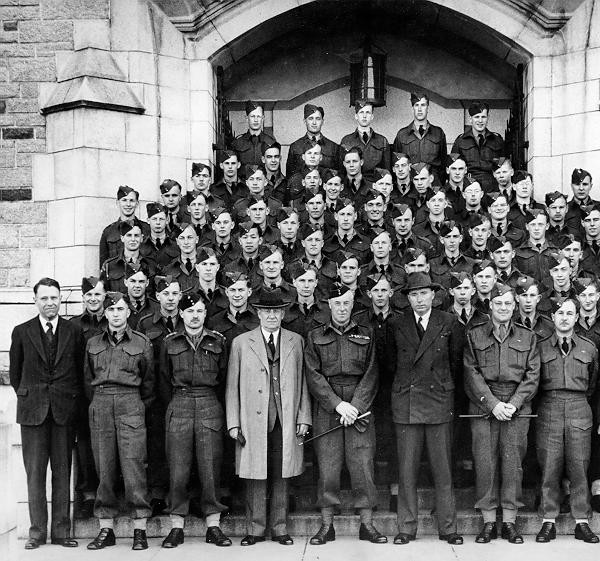
Script
This image is a group photo of a Canadian Army course taught during World War Two. This image is courtesy of UBC Archives. Just as things began to improve after the Great Depression, World War Two broke out. Canada declared war on September 10, 1939. Military training on the campus became popular, then mandatory. World War Two marked the first provision of money from the federal government to the University for research purposes. By the end of the war, it became clear that the facilities at Point Grey had become totally inadequate to cater to the huge influx of veterans returning to their studies.
The University needed new staff, new courses, new faculties, and new buildings for teaching and accommodation. The student population rose from 2,974 in 1944–45 to 9,374 in 1947–48. Surplus Army and Air Force camps were used for both classrooms and accommodation. Fifteen complete camps were taken over by the University in the course of the 1945–46 session alone, with a sixteenth camp situated on Little Mountain in Vancouver, converted into suites for married students. Most of the camps were dismantled and carried by barge or truck to the University where the huts were scattered across the campus. (A few huts remain in place today at UBC). More than 53% of UBC students were war veterans in 1947–67.
13. Column
(Original Image: http://angel.library.ubc.ca/cdm4/item_viewer.php?CISOROOT=/ubcnew&CISOPTR=35679&CISOBOX=1&REC=2)
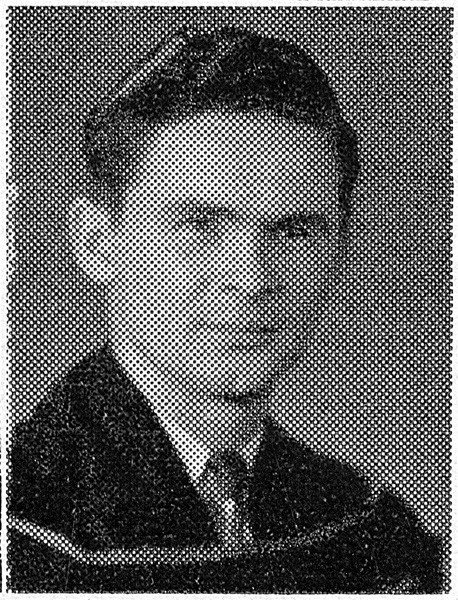
Script:
Welcome to the Irving K. Barber Learning Centre. The following image is Irving K. Barber when he was a student at UBC. This is a photo from the UBC Totem yearbook in 1950. This image is courtesy of UBC Archives.
14. Placard
Script:
Here is Irving Barber at the opening of Irving K. Barber Learning Centre. Image courtesy of UBC Archives. At the Learning Centre, engagement with community transforms service development, learning, and research – it creates commonality, sparks debate, inspires inquiry, encourages contemplation, fosters relevance, and advances excellence. The Learning Centre is dedicated to ensuring that the Learning Centre fulfills UBC’s commitment and the Centre’s inspiring mission in ways that make sense to community, respect community expertise, and provide value to community priorities.
15. Introduction placard (Learning Centre Origins)
Link to full video download to use - https://circle.ubc.ca/handle/2429/2520 (Note: Please use Segment from 31:27 to 42:40)
Script:
Since opening in spring 2008, the Irving K Barber Learning Centre has captivated students, faculty and visitors with its innovative design and service-rich environment. At the Learning Centre, we are dedicated to the University’s academic and community engagement missions, working to support academic excellence and cultivate a sense of community here on campus through space, services, and programming, as well as creating and supporting opportunities for engagement with diverse BC communities. Watch this video of the speech given by Ike Barber at the Official Opening Ceremony of the Learning Centre on April 11, 2008.
House post
UBC’s Point Grey Campus is located on the traditional and ancestral territory of the xʷməθkʷəy̓əm (Musqueam) people. Please see the welcome from Musqueam elder Larry Grant and visit the Musqueam Affiliation page on the Aboriginal UBC website to learn more. UBC’s Okanagan campus is located on the territory of the Okanagan Nation. Visit the Aboriginal Programs and Services site to learn about initiatives and opportunities at the Okanagan campus.
